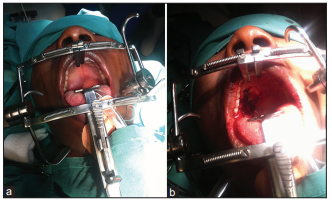Institutional protocol and retrospective analysis of 23 cases of palatal pleomorphic adenoma at a Nigerian tertiary hospital
Main Article Content
Abstract
Background: Pleomorphic adenoma (PA) of the minor salivary gland is the most common benign tumour of the minor salivary glands as majority of the tumours of the minor salivary gland are malignant. The most common site of occurrence of PA of the minor salivary gland is the palate. The major challenges in the surgical management of these cases include management of associated primary haemorrhage and prevention of recurrence. This study documents the experiences gained from management of 23 cases at a Nigerian tertiary hospital.
Methods: A retrospective review of patients who had surgical excision of histologically diagnosed PA of the palate was conducted amongst patients attending maxillofacial outpatient clinic over a 5-year period (January 2012–December 2016). The information retrieved from the patients’ case files included the sociodemographics as well as clinical characteristics. The data were analysed using the Statistical package for the Social Sciences (SPSS) software version 15.0 (SPSS Inc., Chicago, IL, USA).
Results: A total of 23 cases of PA were operated in 23 patients. Fourteen of these were female, while 9 were male, giving a gender ratio of 1:1.5 (m:f). Ages of the patients ranged from 19 to 51 years, with a mean age (standard deviation) at 33 (7.1) years. Clinical symptoms varied from painless asymptomatic palatal swelling to complaints of mild discomfort. The sizes of the lesions ranged from 2 cm to 10 cm in the widest diameter (mean 4.6 ± 3.2 cm). The duration of hospital stay ranged from 7 days to 14 days (mean 5 ± 4.1 days) which was counted from the date of admission to the date of discharge. Surgical treatment in all cases was excision with a margin of grossly intact tissue as well as overlying mucosa.
Conclusion: PA of minor salivary glands of the palate can be complicated by an eventful primary haemorrhage and tumour recurrence. Ligation of related vasculature and complete surgical excision will guarantee cure and uneventful surgery.
Downloads
Article Details
The journal grants the right to make small numbers of printed copies for their personal non-commercial use under Creative Commons Attribution-Noncommercial-Share Alike 3.0 Unported License.
References
1. Hmidi M, Aatifi H, Boukhari A, Zalagh M, Messary A. Pleomorphic adenoma of the soft palate: Major tumor in a minor gland. Pan Afr Med J 2015;22:281.
2. Erdem MA, CankayaAB, Guven G, OlgacV, Kaspoglu C. Pleomorphic adenoma of the palate. J Craniofac Surg 2011;22:1131‑4.
3. Eveson JW, Cawson RA. Tumours of the minor (oropharyngeal) salivary glands: A demographic study of 336 cases. J Oral Pathol 1985;14:500‑9.
4. Cohen MA. Pleomorphic adenoma of the cheek. Int J Oral Maxillofac Surg 1986;15:777‑9.
5. Eisele DW, Richmon JD. Contemporary evaluation and management of parapharyngeal space neoplasms. J Laryngology and Otology 2013; 127:550–5.
6. Bent JP 3rd, Dinges D, Whitehouse A. Pathologic quiz case 1. Minor salivary gland pleomorphic adenoma of the parapharyngeal space. Arch Otolaryngol Head Neck Surg 1992;118:664‑6.
7. Riffat F, Dwivedi RC, Palme C, et al. A systematic review of 1143 parapharyngeal space tumors reported over 20 years. Oral Oncol 2014; 50:421-30.
8. Varghese BT, Sebastin P, Abraham EK, Mathews A. Pleomorphic adenoma of the minor salivary gland in the parapharyngeal space. World J Surg Oncol 2003;1:1‑3.
9. Omeje KU, Efunkoya AA, Amole IO, Osunde OD, Akhiwu BI, Agbara R. Giant pleomorphic adenoma of the major salivary glands: A review of ten cases. Afr J Med Health Sci 2016;2:1‑5.
10. Egyedi P. Utilization of the buccal fat pad for closure of oro‑antral and/or oro‑nasal communications. J Maxillofac Surg 1977;5:241‑4.
11. Tideman H, Bosanquet A, Scott J. Use of the buccal fat pad as a pedicled graft. J Oral Maxillofac Surg 1986;44:435‑40.


